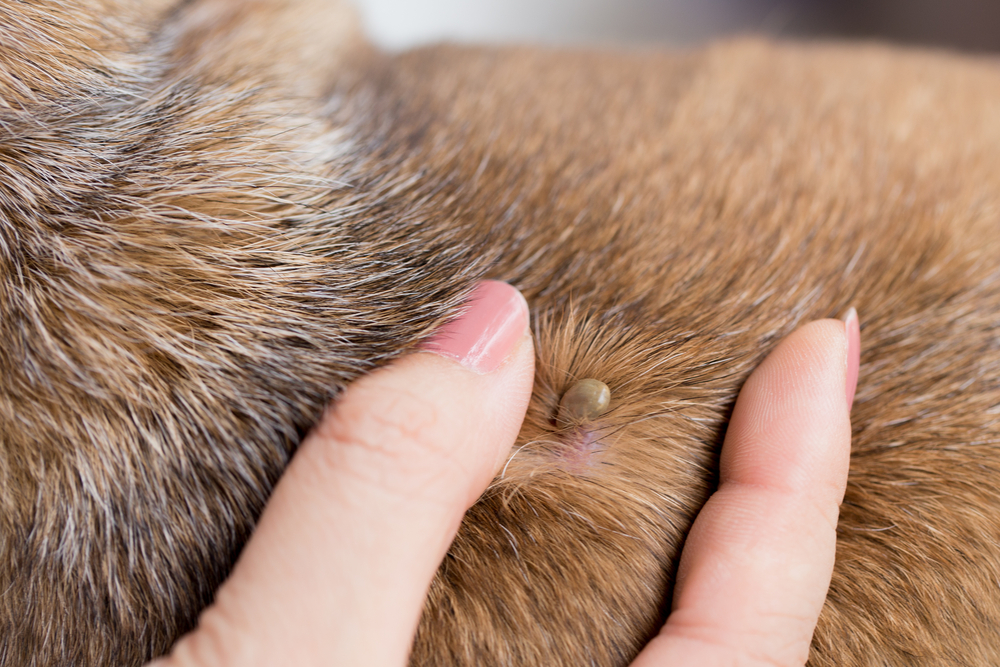5 Ways to Protect Your Pets from Ticks
Ticks: They’re nasty little external parasites that live by feeding on the blood of humans and animals. And, because they spread a number of tick-borne diseases, they’re considered a public health concern by the Centers for Disease Control and Prevention (CDC).
But, you and your pets don’t have to be meals for these blood-thirsty bugs. The key to protecting your human and furry family members from ticks is knowledge. Here are 5 things you need to know to keep ticks away:

#1: KNOW HOW TO SPOT A TICK
Although there are more than 850 known tick species around the world, about 90 of those species have been identified in the continental U.S., and most share a similar life cycle and appearance.
Once they hatch from their eggs, most ticks will go through three life stages: larva, nymph, and adult.
- About the size of a grain of sand, tick larvae have six legs.
- Tick nymphs are approximately the size of a sesame seed and have eight legs.
- Unfed adult ticks are roughly the size of an apple seed and have eight legs.
Until a tick feeds, it is flat and oval. Once a blood meal is consumed, the tick becomes larger and engorged. Ticks have no wings and can be black, brown, yellowish, grayish-white, or reddish-brown in color.
If you notice an insect on you or your pet that appears to be headless, it’s probably a tick. Ticks often bury their heads under the surface of the skin while feeding.
As temperatures warm in the spring and you’re spending more time outdoors, be sure to check your family and your pets for ticks daily.

#2: KNOW WHERE TICKS LIVE
Most ticks prefer wooded, shady areas with tall weeds and grasses. Since they can’t fly, ticks will climb up tall grasses and shrubs and wait for a host to pass by close enough for them to latch on. Rising carbon dioxide levels and body heat alert a tick to the presence of a suitable host.
Although some ticks are active year-round, most are dormant during the winter months and will re-emerge in the spring when temperatures rise above about 50 degrees.
In the fall, thoroughly pick up leaf debris, which is where many ticks will “hide” throughout winter. And, during the warmer months, reduce tick habitat in your yard by controlling weeds and keeping grasses well-groomed.
#3: KNOW WHY TICKS ARE DANGEROUS
Depending on the tick species, the life cycle can take from about 2 months to several years to complete.
Most adult female ticks will breed while on the host animal but will drop to the ground to lay eggs. Female ticks can lay several thousand eggs at a time. After hatching from their eggs, ticks require blood meals during each life stage. Once a tick larva has fed, it will molt (shed its outer skin) into a nymph, and, once a tick nymph feeds, it will molt into an adult.
Regardless of life stage, all ticks are capable of biting and can spread potentially deadly diseases, including:
- Lyme disease (the most common tick-borne disease in the U.S., with more than 35,000 cases reported to the CDC in 2016)
- Ehrlichiosis
- Anaplasmosis
- Babesiosis
- Cytauxzoonosis (cats)
- Alpha-Gal allergy (developing an allergy to meat after being bitten by a lone star tick)
- Rocky Mountain Spotted Fever
- Southern Tick-Associated Rash Illness
- Tick-Borne Relapsing Fever
- Tularemia
- Tick paralysis
#4: KNOW HOW TO REMOVE A TICK
Tick disease can be transmitted within 24 hours of a bite, so, if you find a tick on your pet, it’s important to remove it immediately.
To remove a tick properly:
- Prepare — Gather your supplies, including tweezers, rubbing alcohol, gloves, an empty jar with a lid, and antiseptic wipes or spray.
- Ask for help — If possible, ask a family member or friend to help hold your pet in place, distract him, and keep him calm. For pets motivated by food, use a long-lasting treat, like a cup of frozen peanut butter, to keep him occupied while you remove the tick.
- Remove the tick — Using your tweezers, grab the tick as close to your pet’s skin as possible and pull it out using steady pressure and a straight motion. Avoid twisting or jerking, which could result in the tick’s head or mouthparts being left under your pet’s skin. And, don’t squeeze or crush the tick because it will likely be full of blood.
- Examine the tick — Ensure the tick is intact and the entire head and mouthparts have been removed. If you suspect that part of the tick is still under your pet’s skin, call our office so we can remove the remainder of the tick.
- Kill the tick — Place the tick in your jar with some rubbing alcohol and put the lid on the jar. Keep the dead tick in the jar in case your pet begins to show signs of illness so we can determine what kind of tick bit him and more easily diagnose the tick-borne disease.
- Clean the site — Thoroughly clean the bite site using an antiseptic spray or wipes and keep an eye on the area for several days. If the area becomes infected, you’ll notice increased redness or swelling and will need to contact us.
#5: KNOW THE APPROPRIATE TICK PREVENTION FOR YOUR PET
Prevent ticks from biting your pets and spreading tick-borne diseases. All pets are different, so be sure to talk with us about the tick preventive medication that would be best for your specific pet.









Leave A Comment